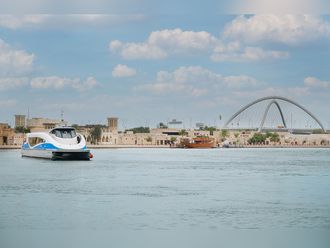GCC countries have the unique distinction of registering the lowest infant mortality rate in the Arab world and the highest life expectancy rate averaging 74.38 years, with women outliving men by a mean average ratio of 4.5 years, according to a recent United Nations Population Fund (UNFPA) report.
Titled "The State of World Population 2002 - People, Poverty and Possibilities," the report encapsulates the various steps taken by the developed and developing countries to fulfil the Millennium Development Goals (MDG) target of cutting in half the number of people living in absolute poverty by 2015. The millennium meet was a sequel to the 1994 International Conference on Population and Development (ICPD), where nations committed themselves to the goal of universal access to reproductive health by the year 2015.
It is amply clear from the country-wise statistics provided in the report's 'Monitoring ICPD Goals - Selected Indicators' section that the policies of the six Gulf countries are on a sound footing and their achievements are highly commendable. The report shows that in controlling the rate of infant mortality, illiteracy and improving health facilities, GCC figures are head and shoulders above Africa, East Europe, South and Central America and most countries in Asia.
Japan, Singapore, Hong Kong, besides the U.S. and Western Europe are some of the few countries that are marginally ahead of the GCC.
On the other hand, life expectancy among GCC nationals is one of the highest in the world with GCC women living an average of 76.61 years and men 72.16 years. The mean average ratio of GCC women outliving their men is 4.5 years, with the coefficient of variation ranging from three to 8.5 years.
Due to better health facilities and other opportunities, women in the UAE live to an average age of 78.4 years, while it is 74.1 years for men. The only exception is Qatar, where women live longer by an average of 8.5 years. The ratio for Qatari women to Qatari men is 79.1:70.6. They are followed by Kuwaiti women - 79 years, while their men lag behind them by an average of 4.1 years.
Omani men and women have the shortest life span compared to their counterparts in other GCC states recording an average of 70.2 and 73.2 years. Whereas in Bahrain it is about 76.3 years for women and 72.1 for men, and in Saudi Arabia it is 73.7 years for women and 71.1 for men.
However, the trend of women outliving men - in varying years - is not restricted only to the GCC. It is more or less a global phenomenon.
The report states that as life expectancies increase over the coming decades, hundreds of millions of women are expected to become widows - with important implications for the provision of social security, health care and housing.
"Widows already make up much of the world's older population. By the mid-1990s more than half of all women over 65 in Asia and Africa were widows, while only 10-20 per cent of men were widowers."
The report projects that the number of people aged 60 and older is likely to more than triple in the next half century, increasing the number of older people in the population from 10 to 22 per cent.
As such, it argues that addressing population concerns is critical to meeting the Millennium Development Goals. Pointing to a 'population effect' on economic growth, the report cites new data showing that since 1970, developing countries with lower fertility and slower population growth have seen higher productivity, more savings and more productive investment. "They have registered faster economic growth," it says.
The report states that a higher life expectancy is a key indicator of health status and stimulates economic growth. Moreover the report says: "An analysis of 53 countries between 1953 and 1990 found that higher adult survival rates were responsible for about 8 per cent of total economic growth."
In the same breath the report points out that income is not the only measurement of poverty and economic growth alone will not end poverty. Escaping poverty depends on improving personal capacities and increasing access to resources, institutions and support, and it includes investment in education and health.
On the score of education, especially female education, GCC countries have made tremendous progress within a short span of time. Enrolment in primary and secondary schools has reached a record high, which in turn has brought down the rate of illiteracy within manageable limits.
In case of the UAE, illiteracy among children under the age of 15 is 24 per cent for boys and 19 per cent for girls. The other figures are Kuwait - 15 per cent for boys and 19 per cent for girls; Saudi Arabia - 16 per cent for boys and 31 per cent for girls and Oman 18 per cent and 35 per cent for boys and girls.
The UNFPA report proves that the member states of the Gulf Co-operation Council (GCC) in general and the UAE in particular are on the right track of meeting the Millennium Development Goals (MDG).
At the millennium meet, world leaders had set eight goals to bridge the worldwide gap between the rich and the poor. The MDG goals are: Eradicate extreme poverty and hunger; achieve universal primary education; promote gender equality and empower women; reduce child mortality; improve maternal health; combat HIV/AIDS, tuberculosis, malaria and other diseases; ensure environmental sustainability and develop a global partnership for development.












